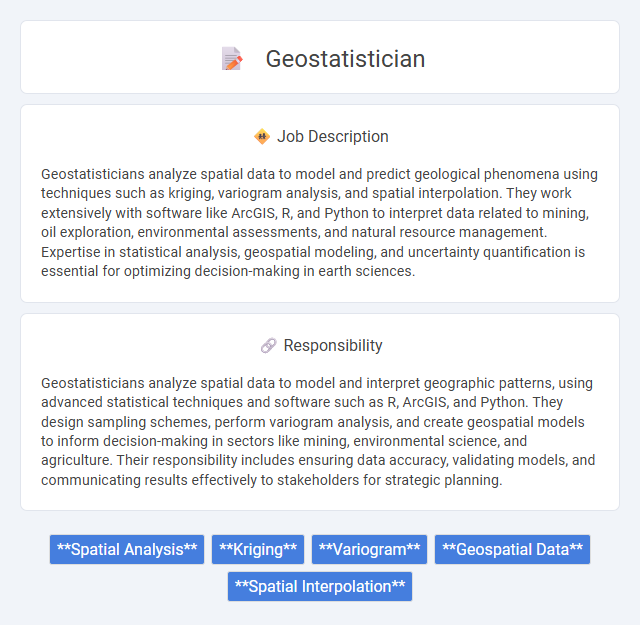
Geostatisticians analyze spatial data to model and predict geological phenomena using techniques such as kriging, variogram analysis, and spatial interpolation. They work extensively with software like ArcGIS, R, and Python to interpret data related to mining, oil exploration, environmental assessments, and natural resource management. Expertise in statistical analysis, geospatial modeling, and uncertainty quantification is essential for optimizing decision-making in earth sciences.
Individuals with strong analytical skills and a keen interest in spatial data are likely to find the geostatistician role well-suited to their capabilities. The job's reliance on interpreting complex datasets and developing models may be challenging for those less comfortable with mathematics or statistics. People who enjoy problem-solving and have patience for detailed, iterative analysis probably have a higher chance of thriving in this career.
Qualification
A Geostatistician typically requires a strong background in statistics, mathematics, and geosciences, often holding a master's or doctoral degree in these fields. Proficiency in spatial data analysis, geostatistical modeling techniques, and software tools such as R, Python, or GIS platforms is essential. Experience with data visualization, machine learning applications in geospatial data, and knowledge of environmental or geological processes enhances the qualification profile significantly.
Responsibility
Geostatisticians analyze spatial data to model and interpret geographic patterns, using advanced statistical techniques and software such as R, ArcGIS, and Python. They design sampling schemes, perform variogram analysis, and create geospatial models to inform decision-making in sectors like mining, environmental science, and agriculture. Their responsibility includes ensuring data accuracy, validating models, and communicating results effectively to stakeholders for strategic planning.
Benefit
Geostatisticians likely benefit from the high demand for expertise in spatial data analysis across industries such as mining, environmental science, and oil and gas. They probably enjoy competitive salaries and opportunities for career advancement due to the specialized skill set required. The role may also provide the advantage of working on impactful projects that influence resource management and environmental policies.
Challenge
The role of a geostatistician likely involves complex data analysis challenges, such as modeling spatial variability and managing large geospatial datasets. The probability of encountering difficulties in integrating diverse geological and environmental datasets may be high, requiring advanced statistical techniques and software proficiency. Problem-solving skills are probably essential to address uncertainties and improve accuracy in predictions related to natural resources or environmental risks.
Career Advancement
Geostatisticians leverage advanced statistical methods and spatial analysis to interpret geological and environmental data, driving decision-making in sectors like mining, oil and gas, and environmental consulting. Career advancement depends on developing expertise in geospatial software, mastering machine learning applications, and gaining experience in complex data modeling to lead large-scale projects. Progression often leads to senior roles such as lead geostatistician, research director, or consultant, with opportunities to influence industry standards and innovation.
Key Terms
Spatial Analysis
Geostatisticians specialize in spatial analysis by applying advanced statistical techniques to model and interpret spatially correlated data across various fields such as environmental science, mining, and urban planning. They utilize tools like kriging, variogram modeling, and spatial interpolation to predict and visualize data patterns over geographic areas, enhancing decision-making processes. Expertise in Geographic Information Systems (GIS) and programming languages like R or Python is essential for managing large spatial datasets and developing robust geostatistical models.
Kriging
Geostatisticians specialize in spatial data analysis, utilizing Kriging as a powerful interpolation method to predict values at unmeasured locations based on observed data points. Kriging enhances accuracy by modeling spatial correlations and minimizing estimation variance, making it essential for resource estimation, environmental monitoring, and mining operations. Proficiency in variogram analysis, stochastic modeling, and geospatial software is critical for effective Kriging implementation in geostatistical projects.
Variogram
A Geostatistician specializes in analyzing spatial data with variograms to model spatial correlation and predict values at unsampled locations. Variograms quantify how data similarity decreases over distance, essential for accurate spatial interpolation in mining, environmental science, and petroleum engineering. Expertise in variogram fitting and interpretation enhances resource estimation and risk assessment in geospatial projects.
Geospatial Data
Geostatisticians specialize in analyzing geospatial data to model spatial relationships and patterns, crucial for resource management, environmental monitoring, and urban planning. They utilize advanced statistical methods and GIS technology to interpret satellite imagery, remote sensing data, and geographic information systems. Expertise in spatial interpolation, kriging, and geospatial data visualization enhances decision-making processes across sectors such as agriculture, mining, and climate science.
Spatial Interpolation
Spatial interpolation is a critical skill for a geostatistician, involving the estimation of unknown values at specific locations based on known data points within a spatial dataset. Techniques such as Kriging, inverse distance weighting, and spline interpolation are commonly applied to create accurate surface models for environmental monitoring, resource exploration, and urban planning. Mastery of spatial interpolation enables geostatisticians to generate predictive maps that support decision-making in industries like mining, agriculture, and meteorology.
 kuljobs.com
kuljobs.com